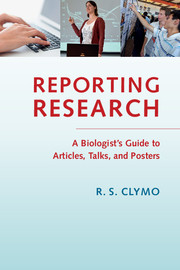3 - Making and displaying a scientific poster
Published online by Cambridge University Press: 05 October 2014
Summary
As scientific meetings got bigger some attendees were not able to give a talk because there was not enough time. The scientific poster was invented to allow these disadvantaged persons to display their work.
Poster sessions have been common for only a few decades, so procedures and poster design techniques are still evolving. The poster is the least formal of the three main communication methods, and corralling viewers for it is competitive. It has the same relationship to the formal article as a painted miniature does to a Vermeer portrait. The advantage of presenting a poster (at anything other than a small meeting for specialists) is that you have an opportunity to interest people outside your special field. It will be clear then that visual presentation is the key to designing a poster that gets noticed. Of the three forms of presentation the poster, as the name implies, is the one that has the largest element of deliberate advertising in it. You need to attract attention. Of course the substance of what you present must be interesting too.
- Type
- Chapter
- Information
- Reporting ResearchA Biologist's Guide to Articles, Talks, and Posters, pp. 87 - 100Publisher: Cambridge University PressPrint publication year: 2014



